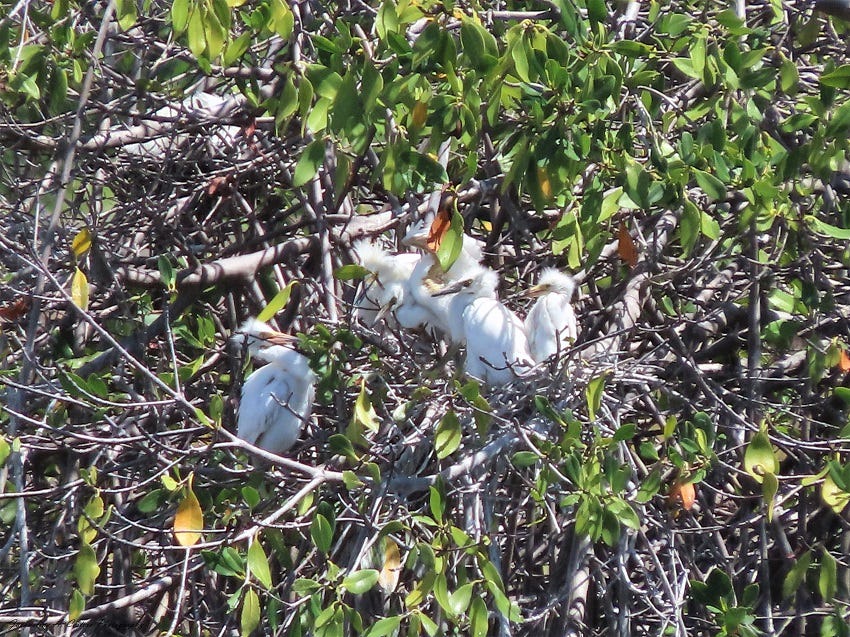The Bee Gees were undoubtedly thinking of the Snowy Eget when they penned these lyrics to their famous song - Stayin’ Alive.
“Well, you can tell by the way I use my walk I'm a woman's man, no time to talk…”
Just look at that strut!
Today Snowy Egrets are one of the most widespread species despite being hunted for their spectacular plumes from 1880 to 1910.
According to Birds of the World:
“This species was among the most sought-after of all herons and egrets for its delicate, recurved back plumes, used to adorn women's hats. In 1886, plumes were valued at an astounding $32 per ounce, twice the contemporary price of gold (Allan 1974). Plundering for plumes began about 1880, peaked in 1903, and continued until 1910, when outraged citizens forced the passage of laws that reduced the slaughter. Hunting continued longer in Central and South America because of continued European demand (Hancock and Kushlan 1984). The species mounted a remarkable comeback following cessation of the feather trade, even extending its range beyond that of historical record.”
Until approximately 2012, Snowy Egrets were considered “Non-Breeding Residents” of Anguilla. This classification was because no one had seen a breeding colony. In January of that year, I began to see the development of a breeding colony that contained a single Great Egret nest at Road Salt Pond. One pair of Snowy Egrets also nested that year.
Over the years, the mangrove stand has expanded, and the location has hosted both Snowy and Cattle Egret nests. Some years are more productive, but 2023 has been a banner year for Snowy Egrets. At least ten nests have been recorded.
This is particularly astonishing considering its location at Road Salt Pond. This wetland, surrounded by controversy over the years (including a proposed Mega Yacht marina), is anything but peaceful. This urban salt pond, once the center of salt production in Anguilla, is now more notable for speeding cars and the thundering trucks of commerce. Decisions by the Government of Anguilla to install flood control measures and clear-cut the natural plantlife around the entire pond to make way for parking during peak social activities have adversely impacted the wildlife within. For some reason, the egrets have learned to work around it all and defy the odds.
Distinguishing the male from the female Snowy Egret is challenging until breeding season. The activity begins in late December as large groups feed around the pond together. The photo above from 2015 is one example of life on Road Salt Pond. Today six birds in this spot would be considered a large gathering.
During the breeding season, the male selects and defends the nest site and displays his stunning plumage to attract a mate. Site selection is usually in a location free from predators with easy access to food.
The female is primarily responsible for constructing the nest made of “loosely woven sticks and twigs.” The male will often bring nest material for the female. Old nest material may be included in the newly constructed bowl.
The nest size is approximately 10 x 16 inches and is round. In Red Mangroves, the nest is placed on top of the foliage for stability.
While the colony has been active since January in varying states, I chose to focus on the nest with the best visibility from my observation point. You can see it in the photograph below. At this stage, she had just laid her eggs unobstructed by foliage.
Snowy Egrets lay three to five pale greenish-blue eggs over approximately two days. They generally have one clutch per season but may relay if the clutch is lost.
Both parents incubate the eggs over approximately 24 days.
Birds of the World describes hatchlings as follows:
“Condition At Hatching
Semialtricial young described in detail by McVaugh (McVaugh 1975). Body length increases from 98.4 mm (hatchling) to 406.4 mm (34 d old). Hatchlings covered by white down except on wings; pinfeathers appear by 1 wk; by 2 wk Juvenile feathers and rectrices emerging. Egg tooth disappears after 2 wk. Leg and mandible color variable from yellow to grayish to black; tarsi always darker than toes. Mouth lining pink; iris generally pale gray. Body mass 20 g (n = 77; KCP).”
Both parents brood the chicks continuously through the first ten days of life.
During the first five days of life, both parents feed the chicks by regurgitating well-digested food into the nest bowl. After that, the chicks grasp the adult bill to stimulate regurgitation directly into the mouth.
Ten days post-hatch, chicks may leave the nest but never stray too far.
At this point in their development, the chicks reach what I fondly refer to as the “Velociraptor” stage. They watch as the parent flies across the pond toward the nest. As it arrives, they maul the adult to try and access the food. There is a feeding hierarchy, with older chicks being fed first. This is best seen in the YouTube companion reel. (Apologies for the camera shake in some segments. Winds and distance from the subject impacted quality.)
Fortunately, the base of the mangrove plant is rich with fish and crustaceans, and the parent can drop down to access more food for those hungry mouths.
Fledglings remain around the colony for up to eight weeks and can often be seen feeding at the base of the mangrove.
I consider the ability to watch the day-to-day activities of this colony another of Anguilla’s many wildlife gifts.
Citation:














What a wonderful presentation Jackie: I learnt a lot! Marie
I love the Snowy Egret! One of my favorite birds. The yellow feet and how graceful they walk! Thanks for the info!